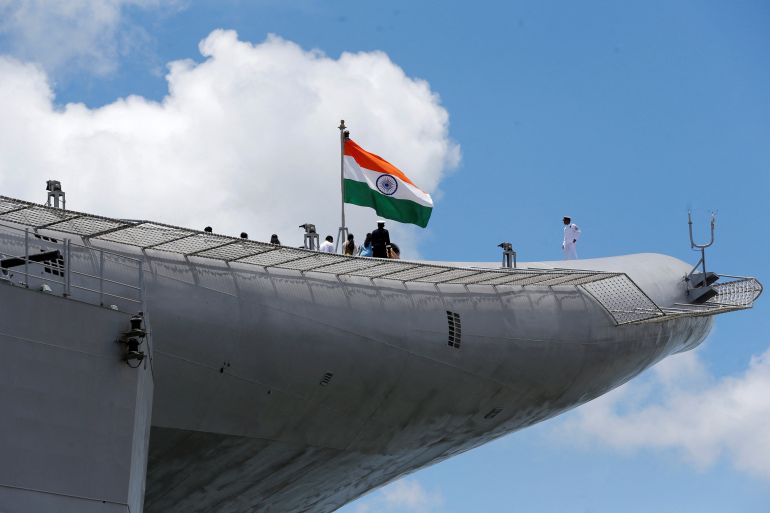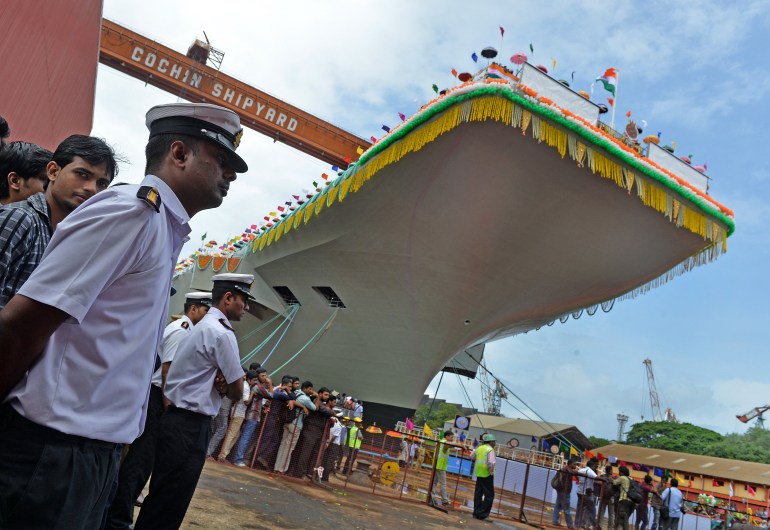INS Vikrant: Why India’s aircraft carrier is no match for China
The recently inducted Vikrant is a naval milestone, yet after all the delays, it starts its life virtually obsolete.

India’s newest and most powerful ship, the aircraft carrier INS Vikrant, was inducted into the navy last Friday. India is currently building a new generation of warships for its navy and the Vikrant is the most visible symbol of Indian pride and industry.
The latest, locally designed and manufactured Indian weapons system, the Vikrant not only highlights the abilities of a maturing military-industrial complex, but is also a powerful reminder of a programme mired in bureaucratic delays and cost overruns. Its capabilities already fall short of what India’s next-generation navy needs.
Keep reading
list of 4 itemsUS report finds possible Israeli violations of international law in Gaza
Russia-Ukraine war: List of key events, day 806
Chad’s President Deby wins election against prime minister in heated race
While keeping one eye on Pakistan, India’s strategic focus has increasingly been on China and its dramatic military expansion, with the People’s Liberation Army Navy, or PLAN, being the main beneficiary. Numerically, it is now the largest navy in the world, with all its ships now designed and built in Chinese shipyards. New designs are being developed at record speeds as China’s navy increases its power and reach to become a truly global force.
India is working hard to develop its own navy as a counter to China’s expansion as tensions between the two countries have risen, recently in the Doklam plateau on the borders of India, China and Bhutan, but also now that India has become a member of the four-nation maritime organisation, the QUAD, aimed at countering China’s influence.
Indian strategists are increasingly focused on what it will take to defeat China in a future naval conflict. Aircraft carriers will play a part in that conflict, but their designs have to be able to stand up to powerful weapons systems coming online. In short, long delays risk obsolescence.
The Vikrant, whilst a milestone for India’s military indigenisation programme, is an older design that is already almost out of date. It is better compared to China’s own first domestically-made aircraft carrier, the Shandong, commissioned in 2019. Both are modified Soviet-era designs.
At about 45,000 tonnes, the Vikrant is even smaller than the older Shandong and both carriers use the older technology “ski-jump” design to give aircraft taking off a much-needed lift.
The Vikrant and Shandong have both been important ships in terms of allowing local designers to develop their own ideas and start to think independently in terms of naval design and manufacture. However, India has been much slower than China in designing these huge warships.

A generation behind
Significant delays haunted the Vikrant. Its keel was laid down in 2009 and the carrier was only commissioned in September 2022, some 13 years in the making. By comparison, the Shandong’s keel was laid down in 2015 and the ship was commissioned four years later. China’s ability to produce increasingly competitive designs, taking them from drawing board to sea trials, far faster than its near-peer competitor India, fits in with China’s wish to produce and field six advanced aircraft carrier groups by 2035.
The Vikrant is a generation behind the design of China’s latest aircraft carrier the high-tech Fujian, launched in June. The first supercarrier to be built outside the United States, it is far larger than the Vikrant, will be able to hold more aircraft, and most importantly uses an electromagnetic system to slingshot aircraft at takeoff. This allows the Fujian to launch far heavier aircraft, laden with weapons and fuel, at a far faster rate than the Vikrant.
The Vikrant’s ski-jump system forces its jets to launch to take off under their own power, which limits the amount of fuel, missiles and bombs the jets can carry. All this means a shorter range for its jets, the length of the Vikrant’s “punch” being significantly shorter than that of the Fujian. In a conflict between carriers, the Vikrant would be significantly outgunned and vulnerable to destruction.
The Vikrant’s woes do not stop there. The ship’s Russian Aircraft Flight Complex, the electronic suite the Vikrant uses to detect and manage the ship’s aircraft when in the air, has had installation issues and is proving hard to integrate into the mostly-Indian design. Planned visits by Russian technicians could be held up because of US-led sanctions imposed on Russia due to the war in Ukraine, further delaying the carrier’s completion.
The Vikrant’s air wing will be made up of Russian MiG-29Ks that are used on its sister ship the aircraft carrier INS Vikramaditya. On paper, these MiGs, adapted for carrier use, seem capable. But the jets have proven unreliable and are heavy, making takeoff and landing risky. The Indian navy is now looking for more advanced aircraft, with France’s Rafale M and the US-made F/A-18 Super Hornet being the likely choices.
Operational in 2023
With delays of more than seven years and a sixfold cost overrun, building the Vikrant has become a mammoth task. In fact, the aircraft carrier is not expected to become operational until at least 2023. The slow turnaround by India’s naval shipyards is in stark contrast to China’s military-industrial complex, which is already working on its second supercarrier that will join the Fujian. Observers predict it will likely be nuclear powered, giving the supercarrier a truly global reach.
Despite the Vikrant being completely outclassed by China’s flagship Fujian carrier, Indian naval designers have learned valuable lessons in the process, which have been applied to its domestic shipbuilding programme.
Currently, 39 ships and submarines are being built in yards around India. India’s next generation of naval vessels will be stealthy frigates and corvettes. Both quick and heavily armed with BrahMos anti-ship cruise missiles, the fastest in the world, they pack a heavy punch. These ships, along with long-range patrol aircraft and new designs of ultra-quiet submarines, may well be the answer to India’s strategic needs, ensuring it has the naval combat power to prevail over China.
This distributed array of next-generation locally-designed and built vessels holds the key to success in any future war, far more than antiquated aircraft carriers that, in the event of a conflict, are likely to become high-profile casualties.